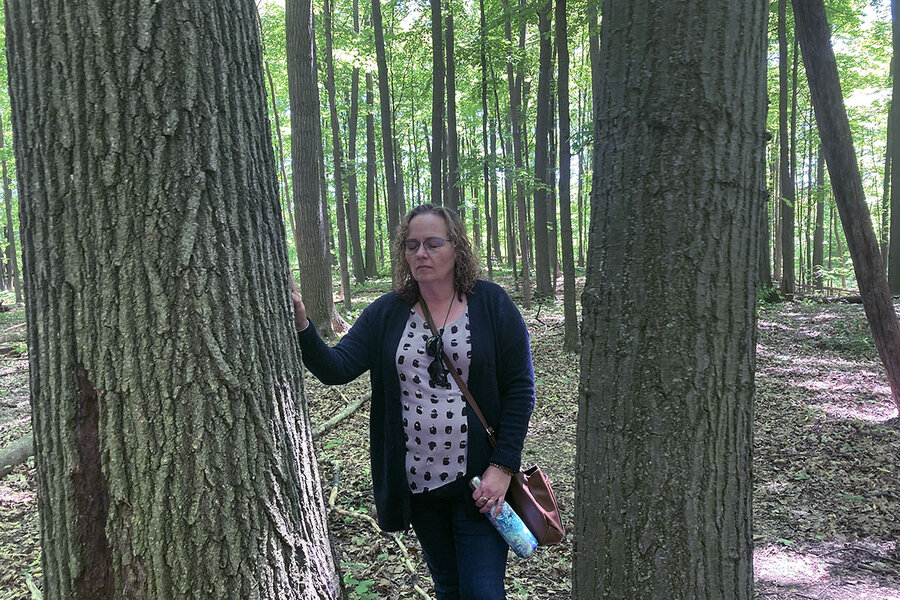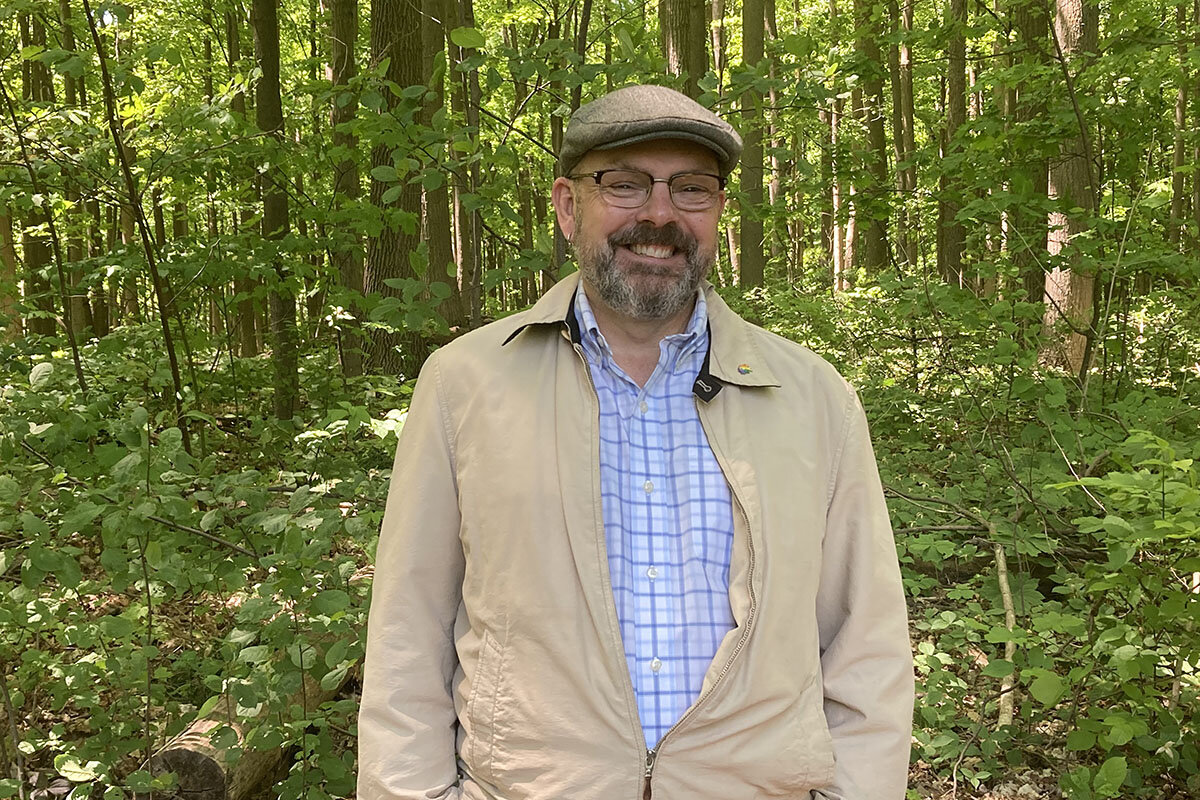‘Creation care’: How churches aim to save a warming planet
Loading...
| Richmond Hill, Ontario
The group stands in a circle at the edge of a forest of maple, aspen, poplar, and oak.
At this “wild church” north of Toronto, member Paula Windsor reads from Hermann Hesse’s “Ode to Trees.” “Nothing is holier, nothing is more exemplary than a beautiful, strong tree,” she reads from the 20th-century work.
When she finishes, the Rev. James Ravenscroft traces the ideas in the secular text to Scripture. “If we pay attention, we hear something similar in a sense when we hear Genesis 2:9,” he tells the dozen congregants of Three Rivers Forest Church on a recent Sunday. “‘Out of the ground, God made to spring up every tree that is pleasant to the sight and good for food. The tree of life was in the midst of the garden, as well as the tree of knowledge of good and evil.’”
Why We Wrote This
The cause of global warming is often framed heavily around science – notably the physics of Earth’s atmosphere. But in the U.S., Canada, and beyond, religious values play a rising role in what many are calling creation care.
There are more readings about trees and their place in cultures and histories around the world. Mr. Ravenscroft leads a meditation, and then he encourages all to walk into the forest of Twickenham Park in Richmond Hill and find a tree with which to connect. “Go with openness,” he says.
In doing so, he is bridging their spirituality with the natural world – and by extension fortifying the fight against global warming. In political and national discourse, climate change activists and churches are often pitted against one another, but many Christians like those in the Wild Church Network see stewardship of the environment as part of their religious mission. They form an important, and often overlooked, base in one of the globe’s most pressing issues.
“My climate activism is not standing outside with a sign,” says Mr. Ravenscroft. “I think it is tapping into something that people are feeling. And partly it’s that we’re super disconnected, and that sense of disconnection is drawing them back into creation to reconnect. And I think part of it is ecologically the crisis of climate change is drawing people. They just recognize that you’re not going to protect something you don’t love. And the best way to fall in love with creation is to spend time with her.”
People concerned about global warming come from all faith-based and secular traditions, of course. But engagement on the issue by people of Christian faith in the United States appears to have risen compared with prior years, across the board from Roman Catholic to evangelical and other denominations, according to a 2020 poll conducted by climate communication programs at Yale and George Mason universities.
In Canada, as the urgency around the climate has grown, many faith communities are beginning to take more concrete political action that goes well beyond their religious convictions, says Karri Munn-Venn, senior policy analyst at Citizens for Public Justice, a Canadian organization that fights for social and environmental justice through a lens of faith.
On a recent morning, the Christian conservation organization A Rocha is hosting a virtual festival to replace a biennial, in-person gathering of national leaders. It’s invited Katharine Hayhoe, a Canadian climate scientist and evangelical living in Texas, as a keynote speaker, and one of her plenary sessions addresses how to respond to climate change with a Christian framework in such a polarized and hostile atmosphere.
She lays out the climate emergency that she has spent her career as an atmospheric scientist studying. And then she reminds the group, which has gathered from around the world, that Christians are taught from Genesis 1 about their responsibility over every living creature. “Rather than dragging our heels at the end of the line, if we really take the Bible seriously, we would be out of the front of the line demanding climate action,” she tells them.
Yet religion and ideology have become so intertwined – a phenomenon largely emerging from the U.S. but affecting Christianity around the world – that often Christian leaders are heard calling climate science hype or a hoax, that scientists are godless, and climate action is a false religion of Earth worshipping.
That zero-sum framework is unrecognizable to many Christians who view protecting the natural world as an extension of their spirituality – and don’t wish to be placed in camps.
“Hope isn’t just twiddling our thumbs”
Leah Kostamo, who co-founded A Rocha Canada, eschews the label “environmentalist.” In the research, education, and sustainable agriculture that it carries out on a farm in British Columbia, it employs Christian language of stewardship and creation care. “There are over a thousand passages in the Bible that mention creation,” she says. “And just like Christians would be for justice, Christians would be for caring for the poor, Christians would be for building community, for helping neighbors – all the best parts of ‘civic’ Christianity – we would want people’s scope of imagination to widen a bit so that Earth stewardship is a normal, natural part of faith.”
Ms. Kostamo, who wrote the book “Planted: A Story of Creation, Calling, and Community,” says their work as Christians is not about throwing up one’s arms. She was inspired by Joanna Macy, an environmental activist, scholar of Buddhism, and author of “Active Hope,” which addresses climate change without despair or doom. “I would say that is a very Christian model of hope, too. Hope isn’t just twiddling our thumbs and saying ‘my hope is God will rescue us from all of this’ or that God is going to wave a magic wand over the climate or over the missing species,” she says. “Hope is more ... we work alongside God in God’s creation for that redemption, whatever that looks like.”
The United Church of Canada, the country’s largest Protestant denomination, has been one of the most progressive on climate change – aiming to reduce its carbon footprint by 80% by 2050 and voting to divest its holdings from the largest fossil fuel companies. But Ms. Munn-Venn says religious Canadians of all faiths are joining the fight.
Her group, along with Kairos Canada, an ecumenical justice organization, launched a faith-in-action campaign in February, targeting key Cabinet ministers in Canada to address the global climate emergency. It follows a campaign they launched with faith groups on Earth Day last year to help push Canada to transition to net zero by 2050.
“One of the things that I’ve observed is a real growth in terms of the number of faith communities in the Christian tradition, but in Muslim and other traditions as well, where creation care and climate action and climate justice are really central pillars,” says Ms. Munn-Venn. One key motivation, she says: “We would have greater potential to have a greater impact if we all came together.”
A renewal for religion?
Victoria Loorz, a co-founder of the Wild Church Network that has its base in the U.S. and Canada, believes that wild churches not only form an environmental base, but are in turn helping to renew faith in religion.
The network has grown since its founding in 2016 to over 100 churches either in operation or in development. The pandemic, which closed so many church doors, spurred interest in not just holding services outside but in connecting with the natural world at a time when church attendance has been in decline. “I really see the wild church movement not just as a cool little ... side thing for people who love nature. I see it as a point of reformation,” she says. “It’s not just to get people involved in the environmental movement, but to restore a severance that we suffer spiritually from, we suffer emotionally from, and obviously we’re suffering ecologically from.”
In the middle of an afternoon in downtown Toronto, the Rev. Jason Meyers of the Metropolitan United Church stands on the church lawn. The church sits at a busy intersection of office space and hospitals, but Taddle Creek once ran through here. “Taddle Creek Wild Church” began gathering here this month, with a poem written by its poet-in-residence, Patricia Orr, to the lost river system.
“Nothing is wasted / Just as the clouds / return the water / that once flowed along Taddle Creek, creek turned rain on the roof of the grand old church,” the first lines read.
For many religious leaders, there is a role for the church in this issue just as there was in fighting against slavery in the 19th century or for the rights of refugees today. For Mr. Meyers, climate change is a top priority, whether that’s reflected in encouraging church members to engage politically, committing to energy efficiencies, or supporting the creation of a wild church.
“In a real way we’re reframing what church is, and pointing towards big issues that we face, like food insecurity, like climate change,” he says. “In the practicing of our spirituality we can engage with these big issues.”








